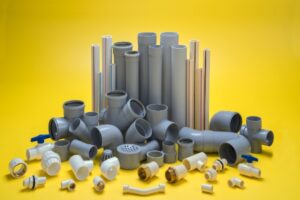If you're a plumber or enjoy DIY projects, it's essential to understand the different products and materials you're working with. For instance, it's common with plumbing projects to run into situations where you must combine different materials. One of these most frequent occurrences is when you need to use PVC fittings with CPVC pipe. However, this begs the question of whether you can combine these two materials.
Although PVC and CPVC are two different types of pipe, they're similar enough that for non-pressure applications, PVC fittings are compatible with CPVC pipe. However, it's essential to use the correct type of glue or cement and to use pipe and fittings that are compatible in size. Otherwise, you risk damaging your pipe and fittings, and the two materials won't be compatible.
PVC vs. CPVC: What's the Difference?
Unless you have a plumbing background or experience, you likely don't know there's a difference between PVC and CPVC. They have nearly identical names and acronyms and look similar to the untrained eye.
However, several key differences exist between PVC and CPVC pipes and fittings. For starters, PVC pipe and fitting measurements are based on the nominal pipe size system (NPS), whereas CPVC measurements can use the NPS or the copper tubing size scale, which is slightly smaller than the NPS. Therefore, it’s important to make sure you choose CPVC NPS. Otherwise, there will be sizing issues.
Another big difference is that PVC stands for polyvinyl chloride, and CPVC stands for chlorinated polyvinyl chloride. While this might not seem like a big difference, the fact that CPVC is chlorinated makes it stronger and more resistant to higher temperatures. For example, PVC starts to break down at 140 degrees, while CPVC can withstand temperatures up to 200 degrees.
Considerations For Using PVC Fittings With CPVC Pipe
If you want to use PVC with CPVC, here are a few things to keep in mind.
The Size Differentials
The fact that PVC and CPVC may use different measuring systems makes it very difficult to use the two materials together. However, because some CPVC products use the NPS system and not the CTS scale, it's possible to combine materials. It's essential, though, that your pipes and fittings use the same measuring system. Otherwise, they aren't compatible.
Type of Cement & Primer
A huge thing to remember when combining PVC with CPVC is the type of glue or cement you're using. PVC glue isn't aggressive enough to adhere to CPVC, so you can never use PVC glue with CPVC pipe. You can, however, use CPVC glue or cement with PVC fittings because it's aggressive enough for CPVC but not too much that it breaks down PVC.
PVC and CPVC Aren't Always Interchangeable
Finally, while using PVC fittings with CPVC pipe is sometimes possible, the two materials aren't interchangeable. Because CPVC has a higher melting point than PVC, it can be used for hot water lines and other areas where it will be subjected to high temperatures. PVC, on the other hand, is typically only used for drains and vents. In other words, it's possible to use CPVC as a substitute for PVC, but you can only sometimes use PVC in place of CPVC for non-pressure applications.
How to Use PVC Fittings With CPVC Pipe
If you're dead set on using PVC fittings with CPVC pipe, here's what you need to do.
1. Ensure that your CPVC pipe is compatible in size with the PVC fittings. To do this, dry fit the end of the CPVC pipe into the PVC fitting to ensure a tight fit.
2. If the sizes are compatible, you can proceed with cement and primer.
3. Start by using a CPVC primer or cleaner to clean the outside of the CPVC pipe where it will insert into the PVC fitting.
4. Prime or clean the inside of the PVC fitting.
5. Follow suit with a CPVC glue by brushing glue on the outside of the CPVC pipe and the inside of the PVC fitting.
6. Stick the end of the pipe into the fitting and give the pipe a slight turn.
7. Hold the pipe in place for five to ten seconds, then let it sit for another 30 seconds.
8. Don't let water run through the pipe for at least an hour because the glue needs time to cure.
Situations Where You Can Use PVC Fittings With CPVC Pipe
As we said before, there are a few situations where it's acceptable to use PVC and CPVC together, as well as ones where it's not appropriate. Here are times when the materials are compatible.
•Plumbing drains and vents.
•Condensation drains for air conditioners.
•DIY projects around the house not involving plumbing.
Conversely, there are situations where you can't use the two materials together.
•Hot water lines where the internal pipe temperature will be higher than 140 degrees.
•Situations where the pipe and fittings will be subjected to high vibration levels.
•Appliance vents where the internal pipe temperature will be higher than 140 degrees.
Additionally, because CPVC products are more expensive than PVC ones, it makes sense to use PVC where it's allowed and CPVC where it's necessary. The only reason to ever combine PVC fittings with CPVC pipe is if you have run out of CPVC fittings and don't feel like running to the hardware store. Even so, this is only allowed if the internal pipe temperature doesn't exceed 140 degrees.
Do Experts Recommend Using CPVC With PVC?
While it's possible in some cases to use PVC fittings with CPVC pipe and vice versa, plumbing experts don't recommend this practice. It simply isn't a good long-term solution to any type of plumbing issue to combine two things with so many different features and qualities. Using the materials together is high risk and low reward, aside from maybe saving a few bucks or minutes of your time.

